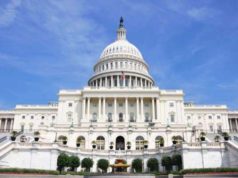
The United States Constitution is a seminal document that established the structure and functions of the federal government. One of the most important aspects of the Constitution is the vesting of powers, which refers to the allocation of authority to the different branches of government. The Constitution meticulously outlines the powers that each branch has, and this division of power is designed to create a system of checks and balances that ensures that no branch has too much power over the others.
The Legislative Branch:
The Constitution vests the legislative power in the Congress of the United States. This means that Congress has the power to make laws, establish taxes and impose tariffs, regulate trade between states and with foreign countries, approve treaties, and declare war. The legislative power is further divided into two separate chambers: the House of Representatives and the Senate. This division is intended to ensure that the laws passed by Congress represent the interests of all citizens and each state equally.
The Executive Branch:
The Constitution vests the executive power in the President of the United States. This means that the President has the power to carry out the laws enacted by Congress, appoint judges and public officials, negotiate treaties, and serve as Commander-in-Chief of the United States Armed Forces. The President is also responsible for representing the United States in foreign affairs and ensuring the smooth functioning of executive agencies.
The Judicial Branch:
The Constitution vests the judicial power in the federal courts. This means that the courts have the power to interpret the Constitution and laws, hear cases and controversies arising under federal law, and make determinations on cases involving disputes between states or the federal government. The judiciary is independent and does not receive direction from the other branches of government.
The Importance of Vesting Powers:
The division of powers is one of the most important aspects of the Constitution. The framers of the Constitution believed that giving each branch a specific set of powers would prevent tyranny and ensure that no single branch became too powerful. They also believed that the division of powers would ensure that the government remained responsive to the people and that the laws and policies enacted by the government would be fair and just.
In conclusion, the vesting of powers in the Constitution is a crucial element in the structure and functioning of the United States government. The division of powers ensures that no single branch becomes too powerful and that the government remains responsive to the needs and interests of all citizens equally. The system of checks and balances that results from the vesting of powers has helped to make the United States a stable and enduring democracy since its founding.
The United States Constitution grants all legislative powers to Congress in Article I, Section I, commonly referred to as the “Vesting Clause.” The “Vesting Clause” exists also in Articles II and III, in which it also delegates the specific powers that are to be granted to other branches of government–the executive branch and judicial branch.
The “Vesting Clause” in the Constitution found in Article I, Section I states: “All legislative Powers herein granted shall be vested in a Congress of the United States, which shall consist of a Senate and House of Representatives.” The language of the text essentially grants all of the legislative authority of the Federal Government to the United States Congress.
The importance of the “Vesting Clause” being employed in the United States Constitution is that it provides for a separation of powers by giving each branch of government-specific powers and authority restricted to that particular branch. That is to say, that the legislative powers given to Congress cannot be exercised or employed by the President because he is part of the executive branch. However, the “Vesting Clause” dictates that the powers granted under Article I of the Constitution are exclusive to Congress.
The vesting clauses found in the other two Articles do not include the words “herein granted,” which enumerates the powers and authoritative provisions in Article I. The other branches of government are not explicitly restricted by the text and are open to exercise certain “implied” powers that may fall under their jurisdiction.
However, Congress has employed a power that was not strictly enumerated in the Constitution: investigations. The Supreme Court has long ago validated and affirmed these powers as a contingency of Congress’ legislative powers. It is important to note that such investigations are limited to the realm of legislative functions. Congress cannot simply undertake an investigation or compel cooperation in an investigation simply for the purpose of uncovering information at random.
Investigations by Congress are to be bound within their legislative powers and authority. This prevents Congress from overstepping its boundaries and journeying out of its imposed jurisdiction because it would violate the doctrine of separation of powers. On the other hand, the courts have provided for quite a broad interpretation of Congress’ powers for investigation. The question of whether Congress is involved in an investigation for ulterior motives would not be a question for the courts. The only concern of the courts would be to determine if such an investigation is within the realm of Congress’ authority of power and regulation.
All those required to cooperate with a Congress investigation are liable to be punished by law if the refusal is given. Under the Constitution, Congress has the authority to levy a punishment of contempt to those who refuse cooperation with a Congressional investigation. All those participating in such investigations are protected by the Constitution and are guaranteed the rights set forth in the Bill of Rights.





















